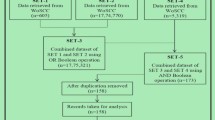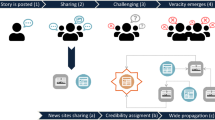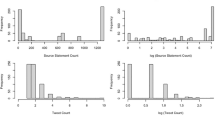Abstract
People can adopt information disseminated in online social networks whenever they receive it frequently from friends or others. Studying this social influence dynamic is crucial to understanding social interactions and users’ behavior regarding online information spread. Quantifying social influence is challenging in online social systems where the interactions and communication content can be closely followed. Here, we study the effects of repeated and diversified influence mechanisms exploring the concepts of Information susceptibility and Adoption thresholds of Twitter users. We consider hashtag and retweet adoptions on different aggregation levels: items, users, and topic groups and study the adoption characterized by diversified and repeated influence stimuli. We address this challenge by tracking the timeline order of potential influence and adopting hashtags and retweets in a specific dataset collected from Twitter, which contains the posts’ dynamics of thousands of seed users and their entire followee networks. We show that users adopt retweets easier than hashtags, and we find both metrics to be heterogeneously distributed, correlated, and dependent on the topics and aggregation level of social influence. We find that new influencing neighbors can effectively trigger adoptions, particularly for topics where a new adopter friend triggers ~ 50% of adoptions. Our results may inform better models of adoption processes leading to a deeper empirical understanding of simple and complex contagion in online social networks.












Similar content being viewed by others
Notes
The maximum number of collected tweets for a user is 3200, which covers their timeline to the past for a varying length depending on their tweeting activity. However, even the most active users may post less than this number over a year, thus setting a cap on this period assures the collection of all tweets for most user over 13 months.
References
Adamic L et al (2015) The diffusion of support in an online social movement: evidence from the adoption of equal-sign profile pictures, pp 1741–1750
Albert R, Barabási AL (2002) Statistical mechanics of complex networks. Rev Mod Phys 74(1):47
Aral S, Walker D (2012) Identifying influential and susceptible members of social networks. Science 337(6092): 337–341
Bakshy E, Hofman JM, Mason WA, Watts DJ (2011a) Everyone's an influencer: quantifying influence on Twitter, pp 65–74
Bakshy E, Hofman JM, Mason WA, Watts DJ (2011b) Identifying influencers on Twitter
Baños RA, Borge-Holthoefer J, Moreno Y (2013) The role of hidden influentials in the diffusion of online information cascades. EPJ Data Sci 2(1):6
Barash V (2011) The dynamics of social contagion. Ph.D. thesis, Cornell University, Ithaca, NY, USA, aAI3485091
Bass FM (1969) A new product growth for model consumer durables. Manage Sci 15(5):215–227
Bearden WO, Netemeyer RG, Teel JE (1989) Measurement of consumer susceptibility to interpersonal influence. J Consum Res 15(4):473–481
Bruning PF, Alge BJ, Lin HC (2018) The embedding forces of network commitment: an examination of the psychological processes linking advice centrality and susceptibility to social influence. Organ Behav Hum Decis Process 148:54–69
Cheng J, Adamic L, Dow PA, Kleinberg JM, Leskovec J (2014) Can cascades be predicted? pp 925–936
Comito C, Forestiero A, Pizzuti C (2019) Word embedding based clustering to detect topics in social media, pp 192–199
Comito C (2020) Next: a framework for next-place prediction on location based social networks. Knowl-Based Syst 204(106):205
Comito C (2021) How covid-19 information spread in us the role of Twitter as early indicator of epidemics. IEEE Trans Serv Comput https://doi.org/10.1109/TSC.2021.3091281
Cox S, Horadam K, Rao A (2016) The spread of ideas in a weighted threshold network, pp 437–447
Davies DL, Bouldin DW (1979) A cluster separation measure. IEEE Trans Pattern Anal Mach Intell 1(2):224–227
de Oliveira JF, Marques-Neto HT, Karsai M (2020) Information adoption via repeated or diversified social influence on Twitter
de Vries DA, Kühne R (2015) Facebook and self-perception: Individual susceptibility to negative social comparison on Facebook. Personal Individ Differ 86:217–221
Dow PA, Adamic LA, Friggeri A (2013) The anatomy of large Facebook cascades. ICWSM 1(2):12.
Gleeson JP, Cahalane DJ (2007) Seed size strongly affects cascades on random networks. Phys Rev E 75(5):056103
Granovetter M (1978) Threshold models of collective behavior. Am J Sociol 83(6):1420–1443.
Granovetter M, Soong R (1983) Threshold models of diffusion and collective behavior. J Math Sociol 9(3):165–179
Hoang TA, Lim EP (2012) Virality and susceptibility in information diffusions
Hoang TA, Lim EP (2013) Retweeting: an act of viral users, susceptible users, or viral topics? pp 569–577
Hoang TA, Lim EP (2016) Tracking virality and susceptibility in social media, pp 1059–1068
Hurd TR, Gleeson JP (2013) On Watts' cascade model with random link weights. J Complex Netw 1(1):25–43
Karampourniotis PD, Sreenivasan S, Szymanski BK, Korniss G (2015) The impact of heterogeneous thresholds on social contagion with multiple initiators. PLoS ONE 10(11):56
Karimi F, Holme P (2013) Threshold model of cascades in empirical temporal networks. Physica A: Stat Mech Appl 392(16):3476–3483
Karsai M, Iñiguez G, Kikas R, Kaski K, Kertész J (2016) Local cascades induced global contagion: how heterogeneous thresholds, exogenous effects, and unconcerned behaviour govern online adoption spreading. Sci Rep 6(27):178
Kitsak M, Gallos LK, Havlin S, Liljeros F, Muchnik L, Stanley HE, Makse HA (2010) Identification of influential spreaders in complex networks. Nat Phys 6(11):888.
Lee RKW, Lim EP (2015) Measuring user influence, susceptibility and cynicalness in sentiment diffusion, pp 411–422
Mensah H, Xiao L, Soundarajan S (2019) Characterizing susceptible users on Reddit's change my view
Mikolov T, Chen K, Corrado G, Dean J (2013) Efficient estimation of word representations in vector space.arXiv:13013781
Minatel D, Ferreira V, de Andrade LA (2021) Local-entity resolution for building location-based social networks by using stay points. Theor Comput Sci 851:62–76
Rogers EM (2010) Diffusion of innovations. Simon and Schuster, New York
Rousseeuw PJ (1987) Silhouettes: a graphical aid to the interpretation and validation of cluster analysis. J Comput Appl Math 20:53–65
Ruan Z, Iniguez G, Karsai M, Kertész J (2015) Kinetics of social contagion. Phys Rev Lett 115(21):218702
Schelling TC (1969) Models of segregation. Am Econ Rev 59(2):488–493
Shannon CE (1948) A mathematical theory of communication. Bell Syst Tech J 27(3):379–423
Twitter I (2020) Twitter developer. https://developer.twitter.com
Tussyadiah SP, Kausar DR, Soesilo PK (2018) The effect of engagement in online social network on susceptibility to influence. J Hosp Tour 42(2):201–223
Unicomb S, Iñiguez G, Karsai M (2018) Threshold driven contagion on weighted networks. Sci Rep 8(1):3094
Unicomb S, Iñiguez G, Kertész J, Karsai M (2019) Reentrant phase transitions in threshold driven contagion on multiplex networks. Phys Rev E 100:040301. https://doi.org/10.1103/PhysRevE.100.040301
Van der Maaten L, Hinton G (2008) Visualizing data using t-SNE. J Mach Learn Res 9(11):2579–2605
Wald R, Khoshgoftaar TM, Napolitano A, Sumner C (2013) Predicting susceptibility to social bots on Twitter, pp 6–13
Wagner C, Mitter S, Körner C, Strohmaier M (2012) When social bots attack: modeling susceptibility of users in online social networks. In: # MSM, pp 41–48
Wang W, Tang M, Shu P, Wang Z (2016) Dynamics of social contagions with heterogeneous adoption thresholds: crossover phenomena in phase transition. New J Phys 18(1):013029
Wasserman S, Faust K (1994) Social network analysis: methods and applications, vol 8. Cambridge University Press, Cambridge
Watts DJ (2002) A simple model of global cascades on random networks. Proc Natl Acad Sci 99(9):5766–5771
Watts DJ, Dodds PS (2007) Influentials, networks, and public opinion formation. J Consum Res 34(4):441–458
Weeks BE (2015) Emotions, partisanship, and misperceptions: how anger and anxiety moderate the effect of partisan bias on susceptibility to political misinformation. J Commun 65(4):699–719
Yağan O, Gligor V (2012) Analysis of complex contagions in random multiplex networks. Phys Rev E 86(3):036103
Acknowledgements
This work was supported by CAPES, FAPEMIG (PPM-00253-18), and the STIC-AmSud Program (Project 18-STIC-07). MK was supported by the DataRedux (ANR-19-CE46-0008) and SoSweet (ANR-15-CE38-0011) ANR projects and the SoBigData++ (H2020-871042) project.
Author information
Authors and Affiliations
Corresponding author
Ethics declarations
Conflict of interest
The authors declare no conflict of interest.
Additional information
Publisher’s Note
Springer Nature remains neutral with regard to jurisdictional claims in published maps and institutional affiliations.
Supplementary Information
Below is the link to the electronic supplementary material.
Rights and permissions
Springer Nature or its licensor (e.g. a society or other partner) holds exclusive rights to this article under a publishing agreement with the author(s) or other rightsholder(s); author self-archiving of the accepted manuscript version of this article is solely governed by the terms of such publishing agreement and applicable law.
About this article
Cite this article
de Oliveira, J.F., Marques-Neto, H.T. & Karsai, M. Measuring the effects of repeated and diversified influence mechanism for information adoption on Twitter. Soc. Netw. Anal. Min. 12, 16 (2022). https://doi.org/10.1007/s13278-021-00844-x
Received:
Revised:
Accepted:
Published:
DOI: https://doi.org/10.1007/s13278-021-00844-x




